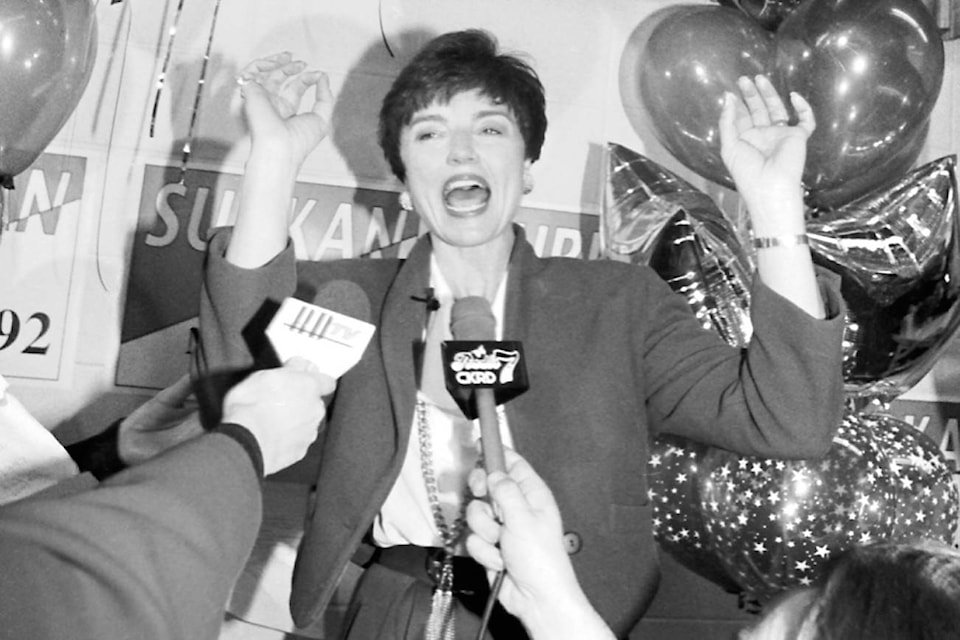Responsibilities of mayor have balanced on the shoulders of two women and 24 men since Red Deer became a city in 1913.
When Gail Surkan, Morris Flewwelling and Tara Veer reflected on their time in the second-floor corner office of City Hall, they pointed to co-operation and creativity as key in Red Deer’s progress over the last 25 years.
Surkan said during her time as mayor, from 1992 to 2004, the city put an emphasis on collaboration, whether with other Central Alberta municipalities, local community groups or institutions.
She said construction of Collicutt Centre was a good example. The facility found a home between Hunting Hills High School and Notre Dame High School by working with the city’s two school jurisdictions. Minor hockey, the gymnastic association and others also pulled together resources for the project.
“As a result of that we developed not only a better facility that served a wider range of people, but also a way of approaching those kinds of major projects in the community based on partnerships,” Surkan said.
Red Deer College’s library was another collaboration.
“We were able to work with the college to develop a prototype which was new in Canada, so far as we know, where the city contributed to the development of the library on the college grounds. Everyone who held a Red Deer Public Library card could use the college library.”
Partnerships extended to local municipalities with the development of Central Alberta Economic Partnership (CAEP), the first of many regional economic development organizations in Alberta, she said.
The city also found consensus with its closest neighbour Red Deer County.
“We were able to work with the county to develop one of the first intermunicipal development plans that really focused on setting out the 25 year or 30 year future, agreeing on the direction of growth and providing for future annexations that wouldn’t be contested or bitter or destructive to the relationship.”
Flewwelling said plenty of seismic shifts occurred during his terms as mayor from 2004 to 2013.
Huge growth in the city’s population along with an economic downturn in 2008, and the tragic deaths of people living rough, made homelessness a top concern, he said.
“What we discovered is the homelessness issue could not be solved by building more emergency housing. It was not going to stop it. It was just going to deal with it. We had to do something to intervene,” Flewwelling said.
The Mayor’s Task Force on Homelessness searched for solutions and came upon the concept of Housing First that focuses on getting people into housing to give them stability and support before dealing with their issues, like mental health or addictions, that make them vulnerable to homelessness.
“That was such a radical way of thinking. That’s why the Buffalo Hotel was converted into Housing First. It took 41 people immediately and then we developed the street teams that go out and find the homeless.”
He said Red Deer led Canada in developing a plan to help the homeless that also included affordable housing. At the time, Red Deer was the first municipality in the country to receive funding from a new federal housing program.
Another worry for Flewwelling was the growing number of Red Deer’s urban aboriginals who faced poverty, discrimination and still wrestled with the multi-generational effects of residential school system.
“I made it my business to directly contact the chiefs and bands in the four reserves at Maskwacis, Sunchild, O’Chiese, and Bighorn.”
Flewwelling assembled an urban elders group that he met with on a regular basis.
He said Red Deer Urban Aboriginal Voices Society was developed to work with governments and community to improve the life of urban aboriginals as a result of the Clearview Ridge fiasco in 2012 when its residents rejected an affordable housing project and cultural centre for the aboriginal community.
Mayor Tara Veer, Red Deer’s current mayor elected in 2013, said since hitting a population of 100,000 Red Deer has stepped into its own in term of its provincial identity and has garnered additional influence.
“In this term alone we’ve realized infrastructure funding for long awaited projects. A great example is the court house after a decade of advocacy, the QEII interchange which was first identified over 20 years ago, and upgrades to Red Deer Regional Airport,” Veer said.
“We also saw on the provincial front a reversal on the previous government’s decision to close Michener Centre and to consolidate ambulance dispatch in Edmonton and Calgary.”
She said the city emerged nationally as hosts of the 2016 MasterCard Memorial Cup and the 2019 Canada Winter Games.
Veer said the downturn in Alberta’s economy has required the city to look at providing public services in new ways and turning regional partnerships into operational partnerships. Extension of Red Deer Transit’s BOLT system to Blackfalds and Lacombe was an example.
“That one decision, in terms of an operational regional partnership, has changed the way Central Albertans live and work and lays the foundation for future opportunities.”
szielinski@www.reddeeradvocate.com
